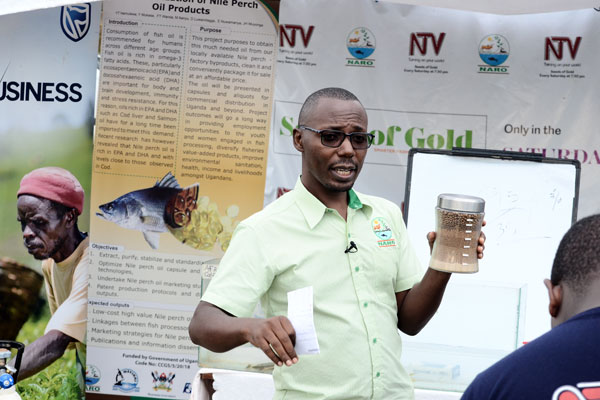How to manage fish feeding

Ivan Ssabwe, a senior aquaculturist, explains bits of fish farming during the recent Seeds of Gold Farm Clinic at MuZardi Photo/George Katongole
What you need to know:
Tilapia fingerlings are omnivorous, feeding mainly on tiny water organisms as well as dead organic matter (detritus) and as they increase in size, they become entirely herbivorous and feed on small water plants.
Proper feeding of fish is almost everything. If you have acquired the best fish seed and have the right aquatic conditions, your major worry should be feeding. Why? Because feeding expenses constitute the bulk of the whole cost of production in any intensive aquaculture setup. Most aquaculturists estimate up to 70 per cent of your budget will be spent on feeds. Seeds of Gold offers expert tips on feeding fish right from feed quality to storage.
Right feed
Complete fish feeds, which are made of carefully selected ingredients to provide all the nutritional requirements [like vitamins, minerals, proteins, lipids and carbohydrates] of the fish, are recommended.
These feeds are made in a form that is easy for fish to feed and digest.
According to Ivan Ssabwe, an aquaculturist with Koudijs, a Dutch feeds company, a careful selection of feeds is important. Ssabwe says it is important to calculate how many kilogrammes of feed the farmer will give to fish over the production period.
There are two types of feeds; the sinking and floating pellet (normally in the sizes above 1mm diameter). Ssabwe says due to the lack of manufacturing equipment in Uganda, most of these feeds are exported from overseas markets, including Brazil, Netherlands, Denmark, Vietnam or China.
“This, naturally means the cost is going to be high,” Ssabwe says.
According to Kaffiika Animal Feeds, tilapia feeds range between Shs3,700-Shs51,000 per kilogramme while catfish feeds range between Shs4,700 and Shs6,600 per kilogramme at retail price. Feed costs can be reduced by use of locally available materials. Samson Luwagga, an agronomist at the Songhai Model Site in Kampiringisa, where integrated production of agricultural crops, raising livestock and fish is practiced, says farm waste can be used to feed fish. He says herbivorous fish such as the tilapia can be fed on live plants especially sweet potato vines.
“Cutting costs is the ultimate motivation of any commercial farmer and by using locally available materials, fish can be fed to satiation while not compromising on the quality,” Luwagga says. Recently, there has been a great interest in the potential of Black Soldier fly larvae as a substitute to fish meal. The National Fisheries Resources Research Institute (NaFIRRI) has conducted successful trials.
Several farmers in other areas such as Masaka and Lira have been trained in turning locally available materials including sweet potato and banana peelings into feeds.
But Andrew Izaara, a senior research officer in aquaculture at the Mukono Zonal Agricultural Research and Development Institute (MuZardi), cautions that generally, the lower the quality of the food (in terms of protein and energy content), the more the fish will have to eat to meet their demands.
How much feed
Ssabwe says fish must be fed to satiation. He argues that is the most economically viable method of feeding fish. He says that feeding rates at a particular meal are influenced by feeding time of the day, body mass, season, and water quality such as temperature and dissolved oxygen levels, among other variables. He explains that with satiation feeding, a farmer should provide small batches of feed continuously until the fish have had sufficient to eat.
“One can know that the fish have had enough to eat when their rate of feeding slows down,” he says.
Using floating pellets, Ssabwe says even a novice fish farmer can easily monitor the feeding response to continue feeding whilst the fish are hungry and stop when feeding slows. Proper feeding, he says, allows maximum growth. As a rule of thumb, Ssabwe says one should feed no more than the fish will consume completely in less than five minutes. But according to Izaara, farmers must avoid overfeeding saying this can be disastrous.
“It can lead to the clogging of the filter and water intoxication. “Naturally fish is very opportunistic, feeding when hungry, but also whenever the food is available,” he says.
Proper feeding
According to Ssabwe, a farmer must be able to train fish for feeding points which helps all fish to feed properly. “Correct feeding practices reduce wastage while helping fish to gain weight in prescribed time,” he adds. Naturally, most fish feed in the early morning and at dusk.
He says it is important to feed fish according to the percentage of its body weight. Farmed fish, he adds, quickly learn who brings the food and will jump at the chance to be fed whenever he/she is around.
Izaara says “if you spot rotting food hovering near the bottom of the tank, it is a clear sign you are overfeeding. This can lead to high ammonia levels in the water and serious health consequences for your fish including obesity and bloating.
Izaara says that generally, most fish do well on one or two feedings per day. “This is because most fish require 16 to 24 hours to fully digest the food they eat,” he says.
Warning
Feeding your fish too often or offering them too much food can lead to several problems.
Both excessive digestive wastes and uneaten food can pollute the water and create high ammonia, nitrite and nitrate levels, and lower the oxygen level as well as lowering the pH levels.
If your water tests show high nitrate levels, it is very likely because you are overfeeding your fish. Further, excessive food floating in the water can clog filters, causing the water to become toxic.




